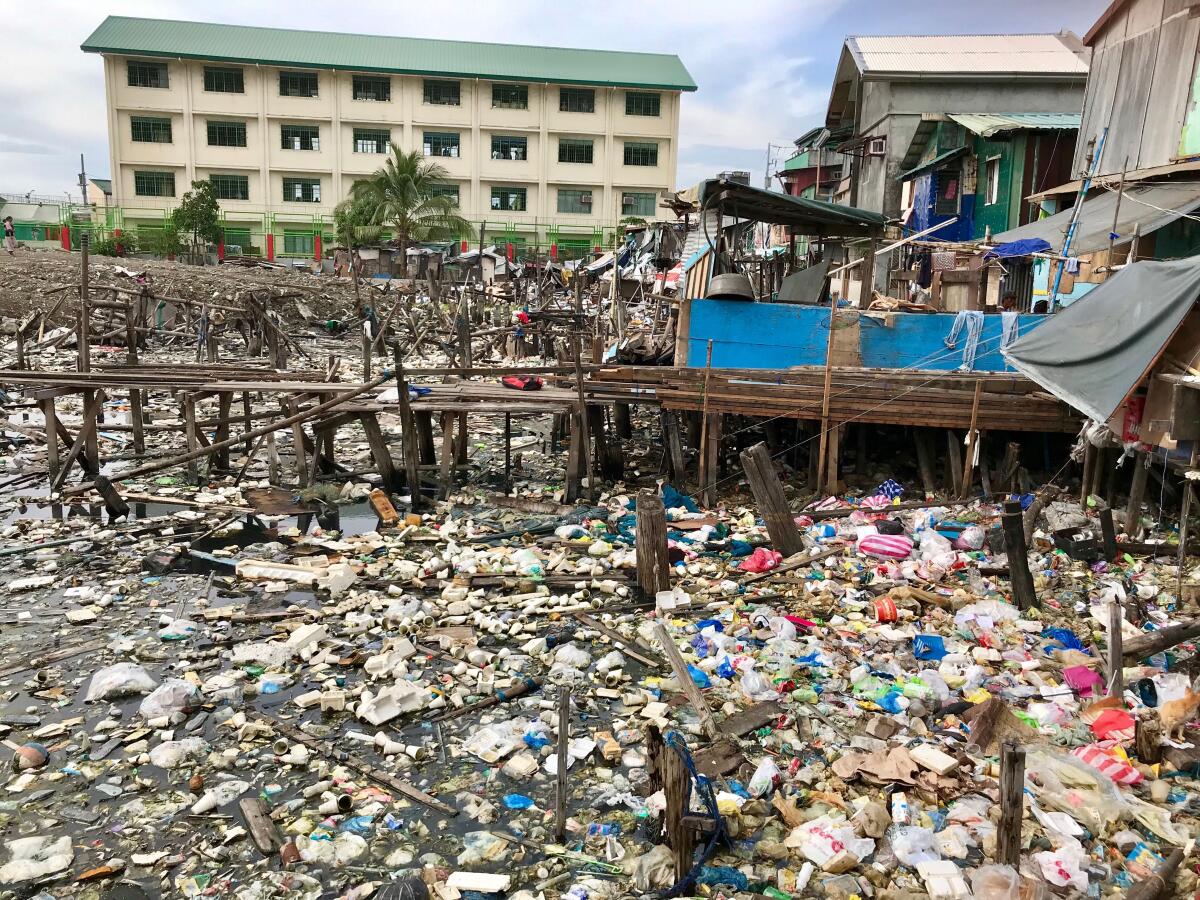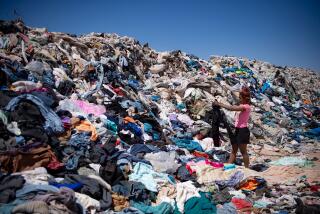Trafficking of plastic waste is on the rise and criminal groups are profiting, report says

WASHINGTON â Americans like to think they are recycling their plastic takeout food containers, cutlery and flimsy grocery bags when they toss them into those green or blue bins. But, too often, that waste is shipped overseas, sometimes with the help of organized crime groups, where it litters cities, clogs waterways or is burned, filling the air with toxic chemicals.
A report published Monday by the independent Swiss research group Global Initiative Against Transnational Organized Crime, whose members include current and former law-enforcement officials, sheds new light on how this waste winds up in poorer countries that had agreed not to accept it.
Building on a previous investigation by Interpol, the new report maps the web of brokers, middlemen, legitimate recycling companies and organized crime groups that move millions of tons of discarded plastic from the United States, Europe and Australia to countries in Southeast Asia and Africa.
Virginia Comolli, the reportâs main author, says the illicit aspect of the trade is already a significant problem and on the rise.
âGiven the existing trends in terms of our addiction to plastic â and looking at future projections that itâs likely to increase â we are likely to also see an increase in these criminal activities,â Comolli added.
According to the report, data from the federal government suggests California is especially culpable. Plastic scrap generated in the state accounted for nearly a third of all U.S. exports to developing countries this year and is the main source of banned plastic exports to Malaysia.
Jan Dell, a chemical engineer and founder of the California-based environmental group The Last Beach Cleanup, said part of whatâs driving this flood of exported plastic is that the state has very few recycling plants for its size. Itâs also home to the Port of Los Angeles, the main U.S. entry point for goods from Asia. Once those shipping containers are emptied, they can be refilled with Californiansâ plastic scrap and send back across the Pacific Ocean at relatively little cost.
The report draws on interviews with law enforcement authorities around the world, waste regulators and industry insiders. It lays out the tactics that exporters use to skirt international efforts to curb shipments of plastic scrap from wealthier countries to poorer ones, such as hiding behind multiple shell companies and complex shipping routes that make it difficult for receiving countries to send the waste back.
In 2017, China announced that it would no longer serve as the âworldâs garbage dumpâ and stopped accepting plastic scrap shipments.
Two years later, more than 180 countries â not including the U.S., which refused to sign the agreement â pledged to fight plastic pollution by enacting new control measures. They agreed that wealthy countries could no longer export hazardous plastic waste to developing nations. The European Union went a step further, adopting more stringent rules that only allow the export of so-called clean plastic waste fit for recycling to poorer countries.
But tons of low-quality, difficult-to-recycle plastic scrap is still finding its way to developing countries, in part, Comolli found, because waste exporters are circumventing the regulations.
The report found that legitimate recycling companies and waste brokers have engaged in fraud, concealing shipments of banned plastic products among other goods, illegally dumping them and paying bribes to get past inspectors. Exporters have also mislabeled their cargo so that that the plastic scrap incorrectly appears to be in compliance with international agreements, disguising it from customs officers.
Many of the companies alleged to have committed crimes arenât named in the report, often because they havenât been formally charged with anything. But one example given of the trends in waste shipping is that of Biffa Waste Services, one of the largest waste companies in Britain. It was fined 350,000 pounds in 2019, the equivalent of more than $470,000 today, for shipping contaminated residential waste to China that it had labeled as paper fit for recycling.
Even the shipping routes used to move plastic waste around the world are often designed to incorporate multiple stops in different countries, so that by the time an illegal shipment arrives at its final destination itâs not clear where it came from. This makes it difficult for regulators in Indonesia, Malaysia and the Philippines â countries that are making an effort to send back banned plastic scrap â to return them to their origins.
âThis is nothing other than the traditional cat-and-mouse dynamic well known to police and customs officials around the word: As enforcement tightens its grip, criminals look for new ways and places to carry out their activities,â the report said. âIn the case of illicit waste flows, this is likely to translate into greater proliferation of routes towards places with weaker enforcement capacity.â
Asian countries are still the top destination for illicit plastic scrap. But the report found that Turkey and some countries in Eastern Europe, such as Poland and Bulgaria, are also seeing in influx.
Romanian law enforcement authorities have acknowledged that organized crime groups are involved in the trade of banned plastics â but so are seemingly legitimate businesses. The report cites an industry specialistâs account of large, politically connected cement companies in Romania that are using shell companies to import banned plastic waste.
Turkey has become âa key nodeâ in the trade of banned plastic waste from European countries, the report said, because of its permissive regulatory environment, its financial interest in generating revenue from receiving foreign waste and the presence of criminal groups.
Once the waste reaches its destination, Comolli found that pollution investigators often donât have the technical knowledge or resources to trace it back to its source or peel back the layers of shell companies to reveal who is trying to bring the waste into their countries. Regulators in some countries have been able to form alliances to share information, but this is still relatively uncommon.
Although America is one of the top producers of plastic waste, regulators in the U.S. arenât leading the way in this area. Because the U.S. didnât ratify the 2019 agreement on shipping low-quality plastic scrap, American companies are continuing to send waste to countries like Malaysia and Indonesia â even though it is now illegal for those countries to accept it.
Without a vote from Congress to sign on to the international agreement, the federal government has limited options to stop these exports.
The economic factors driving this trade are not new. It has long been cheaper for cities and towns in the U.S. and Europe to pay exporters to ship their plastic waste somewhere else rather than send it to a landfill or a recycling facility. And once theyâve sold it to a broker, they often donât know where it ends up.
Californiaâs policies on waste disposal arenât helping, Dell said. A 2011 state law intended to reduce the stateâs reliance on landfills set a goal for cities and counties to recycle 75% of their waste by 2020. But it doesnât ban them from exporting it, Dell said.
State officials âdidnât do the math and say, âIs there a way to recycle this material?â They just effectively said to the cities: âYou go figure out it,ââ Dell said.
Lawmakers and environmental advocates in California have called for the Biden administration to ratify the Basel Convention, the international agreement governing shipments of plastic waste. But until that happens, responsibility for not shipping this scrap to poorer countries depends on voluntary pledges by cities and recycling companies.
More to Read
Sign up for Essential California
The most important California stories and recommendations in your inbox every morning.
You may occasionally receive promotional content from the Los Angeles Times.











